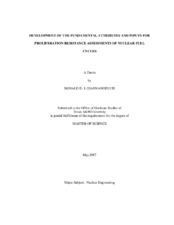Development of the fundamental attributes and inputs for proliferation resistance assessments of nuclear fuel cycles
Abstract
Robust and reliable quantitative proliferation resistance assessment tools are
critical to a strengthened nonproliferation regime and to the future deployment of
nuclear fuel cycle technologies. Efforts to quantify proliferation resistance have thus far
met with limited success due to the inherent subjectivity of the problem and
interdependencies between attributes that contribute to proliferation resistance. This
work focuses on the diversion of nuclear material by a state and defers other threats such
as theft or terrorism to future work. A new approach is presented that assesses the
problem through four stages of proliferation: the diversion of nuclear material, the
transportation of nuclear material from an internationally safeguarded nuclear facility to
an undeclared facility, the transformation of material into a weapons-usable metal, and
weapon fabrication. A complete and concise set of intrinsic and extrinsic attributes of the
nation, facility and material that could impede proliferation are identified. Quantifiable
inputs for each of these attributes are defined. For example, the difficulty of handling the
diverted material is captured with inputs like mass and bulk, radiation dose, heating rate and others. Aggregating these measurements into an overall value for proliferation
resistance can be done in multiple ways based on well-developed decision theory.
A preliminary aggregation scheme is provided along with results obtained from
analyzing a small spent fuel reprocessing plant to demonstrate quantification of the
attributes and inputs. This quantification effort shows that the majority of the inputs
presented are relatively straightforward to work with while a few are not. These few
difficult inputs will only be useful in special cases where the analyst has access to
privileged, detailed or classified information.
The stages, attributes and inputs of proliferation presented in this work provide a
foundation for proliferation resistance assessments which may use multiple types of
aggregation schemes. The overall results of these assessments are useful in comparing
nuclear technologies and aiding decisions about development and deployment of that
technology.
Subject
nuclearnonproliferation
nuclear security
proliferation resistance
nuclear power
reprocessing
uranium enrichment
nuclear weapons
nuclear terrorism
Citation
Giannangeli, Donald D. J., III (2003). Development of the fundamental attributes and inputs for proliferation resistance assessments of nuclear fuel cycles. Master's thesis, Texas A&M University. Texas A&M University. Available electronically from https : / /hdl .handle .net /1969 .1 /5861.
Related items
Showing items related by title, author, creator and subject.
-
Hardin, David Denton (Texas A&M University. Libraries, 1977)The angular singularities of the multigroup neutron diffusion equations are studied. The solution of the diffusion equations may have unbounded derivatives at points where the boundary has a corner, where two material ...
-
Devous, Michael David (Texas A&M University. Libraries, 1976)Levels in ¹⁵³Tb populated by the decay of 6.3-h ¹⁵³Dy and in the ¹⁵³Eu (α,4ny)¹⁵³Tb reaction have been studied using Ge(Li), Si(Li), and plastic scintillator detectors for y-ray singles, conversion-electron singles, y-y ...
-
Freeman, Bridger HayesAs the interest in space exploration becomes ever more relevant, so too do the health risks of space. For humans, the eyes are one of the most vulnerable organs to radiation. Though there is notable previous research that ...


